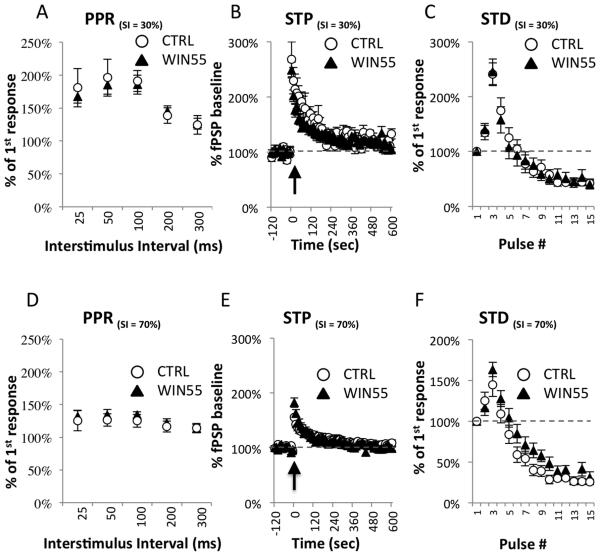Figure 2.
Short-term plasticity at the L2/3→L5 synapse is unaffected in WIN55- treated mice.
(A-C) Short-term measures of plasticity were measured at 30% stimulus intensity. (A) Paired-pulse ratios (PPR) were measured at the L2/3→L5 synapse at 5 different interstimulus intervals (25, 50, 100, 200, and 300 ms). No differences in mean PPR were observed between CTRL (n = 6) or WIN55-treated (n = 10) animals at any interval tested; all p-values > 0.05. (B) Short-term potentiation (STP) was induced with a brief train of 15 pulses delivered at 50 Hz at time 0 (indicated by a black arrow). RM-ANOVA between WIN55-treated (n = 10) and CTRL (n = 6) samples showed no time × treatment interaction (F(1.6,21.3) = 1.568, p = 0.232). (C) Short-term depression (STD) was measured during the train used to simulate STP. Each response in the train was compared to the fPSP amplitude at baseline and plotted as a percentage. Depression across the train was observed in all groups, with facilitation being favored in the early portion of the train. RM-ANOVA revealed no significant pulse# × treatment interaction (F(2.1, 28.7) = 0.284, p = 0.760). (D-F) Short-term measures of plasticity were also measured at 70% stimulus intensity. (D) PPRs were measured at 5 different inter-stimulus intervals (25, 50, 100, 200, and 300 ms). No differences in PPR at 70% stimulus intensity were observed between CTRL (n=6) and WIN55-treated (n=10) animals using independent samples t-tests; all p-values > 0.05. (E) RM-ANOVA on STP at 70% stimulus intensity between WIN55-treated (n=10) and CTRL (n=6) samples showed no time × treatment interaction (F(2.1, 29.5) = 1.501, p = 0.239). (F) At 70% stimulus intensity, depression across the train was observed in both groups, with facilitation being favored in the early portion of the train but to a lesser extent than at 30% stimulus intensity. RM-ANOVA revealed no significant pulse# × treatment interaction F(4,56) = 2.154, p = 0.086.

